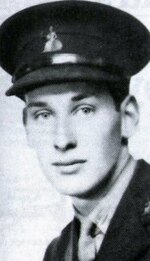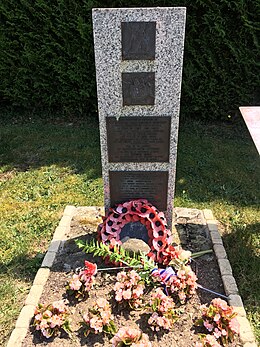| David Jamieson | |
|---|---|
 | |
| Born | (1920-10-01)1 October 1920 Westminster, London, England |
| Died | 5 May 2001(2001-05-05) (aged 80) Burnham Market, Norfolk, England |
| Buried | Burnham Norton Churchyard, Norfolk |
| Allegiance | United Kingdom |
| Service | British Army |
| Years of service | 1939–1948 |
| Rank | Major |
| Service number | 90577 |
| Unit | Royal Norfolk Regiment |
| Battles / wars | Second World War |
| Awards | Victoria Cross Commander of the Royal Victorian Order |
| Relations | Sir Archibald Jamieson (father) |
Major David Auldjo Jamieson, VC, CVO (1 October 1920 – 5 May 2001) was a British Army officer in the Second World War who received the Victoria Cross, the highest award for gallantry in the face of the enemy that can be awarded to British and Commonwealth forces.
Early life
David Auldjo Jamieson was born in Westminster on 1 October 1920, the elder son of Sir Archibald Auldjo Jamieson, Chairman of Vickers Armstrong. He attended Ladycross School, Seaford, East Sussex, and Eton College. In his youth he spent time at the family holiday retreat in Norfolk. He was a volunteer in the Territorial Army unit at Dersingham for the 5th Battalion, Royal Norfolk Regiment, which he joined in May 1939 when the Territorial Army was doubled in size. He was transferred to the 7th Battalion, formed as a 2nd Line duplicate of the 5th, and was subsequently commissioned as a second lieutenant, despite a lack of experience.
Second World War
Aged 19 on the outbreak of the Second World War, Jamieson was considered too young for overseas service and did not initially go with the battalion, now part of the 51st (Highland) Infantry Division, to join the British Expeditionary Force (BEF) when it went to France in 1940 but followed later. When the majority of the battalion was captured in June 1940 during the Fall of France he was at Rouen and was able to return to Britain. The battalion was reformed in 1941 and he was promoted to a company commander of D Company.
Victoria Cross
Jamieson was a 23-year-old captain in the 7th Battalion of the Royal Norfolk Regiment, now part of the 176th Infantry Brigade attached to the 59th (Staffordshire) Infantry Division, when the following deed took place for which he was awarded the Victoria Cross. On 7/8 August 1944, south of Grimbosq, Normandy, France, Jamieson was in command of D Company, being the only officer remaining, which had established a bridgehead over the River Orne. The enemy made seven counter-attacks on the company's position, but throughout 36 hours of bitter and close fighting Captain Jamieson's company refused to give up. The attacks included assaults with Tiger and Panther tanks which shot up the Churchill tanks supporting the Royal Norfolks'.
Jamieson was giving map references for British artillery; directing the resources of first the divisional artillery, then the medium artillery of the corps.
Jamieson at one point mounted the last British tank to talk to the commander under enemy fire in order to direct the tank to retreat He dismissed it as anything heroic, saying that he had to as the telephone didn't work – tanks were equipped with an external handset so that the commander could talk to an infantry commander without opening the hatch. The image of Captain Jamieson riding a Churchill tank while enemy tanks attacked was immortalised in a painting. As he was talking to the commander, the tank was hit and Jamieson blown off. He returned to his "hole" where he received treatment - he had lost an eye and was bleeding from his arm. After relief by another battalion, Jamieson was evacuated to a first aid post and then back to the UK.
The citation for Captain David Jamieson in the London Gazette of 26 October 1944 ends:
...Throughout the thirty six hours of bitter and close fighting and in spite of the pain of his wounds, Captain Jamieson showed superb qualities of leadership and great personal bravery. There were times when the position appeared hopeless, but on each occasion it was restored by his coolness and determination. He personally was largely responsible for the holding of this important bridgehead over the River Orne and for the repulse of seven German counter-attacks with great loss to the enemy.
Post-war
Following the war, he worked for the Australian Agricultural Company, which ran several sheep and cattle stations; he became a director in 1949 and was Governor from 1951 to 1975. He was also director of other companies including National Westminster Bank. Due to his height, 6 ft 5, he was designated the ceremonial umbrella man to Queen Elizabeth, the Queen Mother, carrying an umbrella over her at social functions.
In 1948 he married Nancy Elwes, who died in a car accident in 1963. He remarried, to Joanna Windsor-Clive, in 1969. He was appointed High Sheriff of Norfolk in 1979.
He died on 5 May 2001 in Burnham Market, Norfolk, and was interred in the churchyard in Burnham Norton. He was survived by his widow, his son Andrew Jamieson, and two daughters of his first marriage, three grandchildren, and by a stepson and stepdaughter.

Medals
David Jamieson's Victoria Cross is displayed in the Royal Norfolk Regimental Museum in Norwich Castle.
Jamieson was awarded the following service and commemorative medals:
- 1939–45 Star
- France and Germany Star
- Defence Medal
- War Medal
- Queen Elizabeth II Coronation Medal
- Queen Elizabeth II Silver Jubilee Medal
Bibliography
- John, Laffin (1997). British VCs of World War 2: A Study in Heroism. Sutton Publishing. ISBN 0-7509-1026-7.
- Buzzell, Nora, ed. (1997). The Register of the Victoria Cross. Cheltenham, Gloucestershire: This England Alma House. ISBN 0-906324-27-0.
- Bailey, Roderick (2011) . Forgotten Voices of the Victoria Cross. Ebury.
References
- "Major David Jamieson VC". Daily Telegraph (UK). 8 May 2001.
- ^ Goldstein, Richard (12 May 2001). "David Jamieson, 80, Winner of Top British Medal for Valor". The New York Times.
- Bailey 2011 p 269
- Bailey 2011 p 269-270
- "No. 36764". The London Gazette (Supplement). 24 October 1944. p. 4899.
- Royal Norfolk Regimental Museum
- 1920 births
- 2001 deaths
- British Army personnel of World War II
- British Army recipients of the Victoria Cross
- British World War II recipients of the Victoria Cross
- Commanders of the Royal Victorian Order
- English people of Scottish descent
- High sheriffs of Norfolk
- Honourable Corps of Gentlemen at Arms
- People educated at Eton College
- People educated at Ladycross School
- People from Burnham Market
- Military personnel from Westminster
- Royal Norfolk Regiment officers
- British Battle of Normandy recipients of the Victoria Cross
- Burials in Norfolk